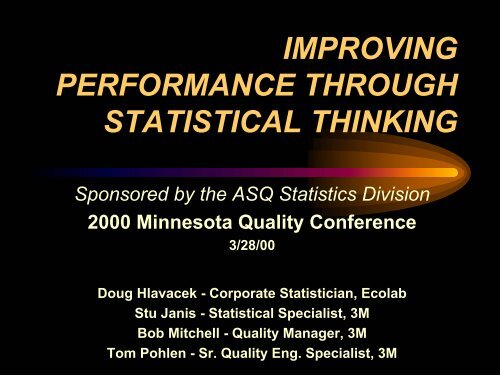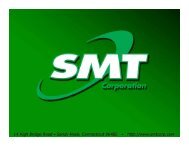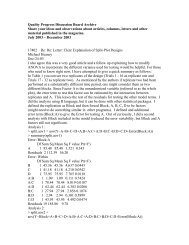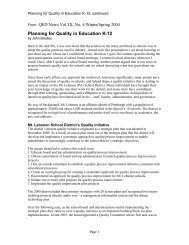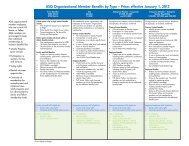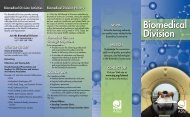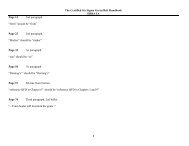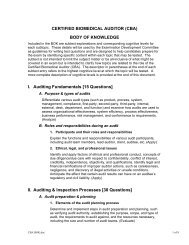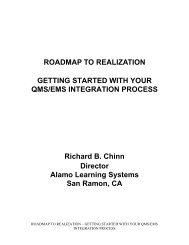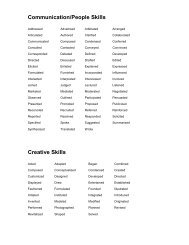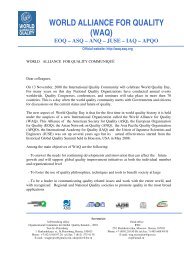IMPROVING PERFORMANCE THROUGH STATISTICAL THINKING
IMPROVING PERFORMANCE THROUGH STATISTICAL THINKING
IMPROVING PERFORMANCE THROUGH STATISTICAL THINKING
You also want an ePaper? Increase the reach of your titles
YUMPU automatically turns print PDFs into web optimized ePapers that Google loves.
<strong>IMPROVING</strong><br />
<strong>PERFORMANCE</strong> <strong>THROUGH</strong><br />
<strong>STATISTICAL</strong> <strong>THINKING</strong><br />
Sponsored by the ASQ Statistics Division<br />
2000 Minnesota Quality Conference<br />
3/28/00<br />
Doug Hlavacek - Corporate Statistician, Ecolab<br />
Stu Janis - Statistical Specialist, 3M<br />
Bob Mitchell - Quality Manager, 3M<br />
Tom Pohlen - Sr. Quality Eng. Specialist, 3M
Kahneman & Tversky<br />
Experiment #1<br />
Which would you choose?<br />
A) Take a gamble:<br />
- 80% chance of winning $4000<br />
- 20% chance of winning nothing<br />
B) Take a sure thing:<br />
(100% chance) of receiving $3000<br />
2
Kahneman & Tversky<br />
Experiment #2<br />
Which would you choose?<br />
A) Take a gamble:<br />
- 80% chance of losing $4000<br />
- 20% chance of breaking even<br />
B) Take a sure thing:<br />
(100% chance) of losing $3000<br />
3
Kahneman & Tversky<br />
Prospect Theory<br />
- Risk Experiments -<br />
Experiment 1<br />
20% (100%) 80%<br />
0 $3000 $4000<br />
Experiment 2<br />
80% (100%) 20%<br />
-$4000 -$3000 0<br />
4
Kahneman & Tversky:<br />
“Prospect Theory” Findings<br />
• We tend to be inconsistent in the way we<br />
make decisions involving gains versus<br />
decisions involving losses.<br />
– When the choice involves gains, we are riskaverse.<br />
– When the choice involves losses, we are risktakers.<br />
• We tend to be driven mostly by “loss<br />
aversion”<br />
Source: Against the Gods<br />
by Peter L. Bernstein<br />
5
Outline<br />
• Introduction and motivation - 45 minutes<br />
• What is Statistical Thinking? - 3 hours<br />
• Lunch<br />
• How can I apply Statistical Thinking<br />
effectively in my organization? - 3 hours<br />
• Summary - 15 minutes<br />
Note: All sessions (except the summary) will<br />
involve interactive team breakouts. We are not<br />
smart enough to tell you the answers!<br />
6
I. Introduction and<br />
Motivation
Overall Goal<br />
• To better prepare attendees to apply<br />
Statistical Thinking effectively within<br />
their own organizations, to deliver<br />
improved results<br />
• To identify ways to get management<br />
to lead it<br />
8
Objectives<br />
• Obtain a common understanding of<br />
Statistical Thinking, its definition, and its<br />
application<br />
• Clarify the distinction between Statistical<br />
Thinking and statistical methods<br />
• Provide practice applying Statistical<br />
Thinking to real situations<br />
• Provide attendees the opportunity to<br />
address implementation issues specific to<br />
their situations<br />
9
Example: Customer<br />
Complaints<br />
Month % Reject Month % Reject Month % Reject<br />
Jan-91 .001 Jan-92 .033 Jan-93 .001<br />
Feb-91 .032 Feb-92 .035 Feb-93 .000<br />
Mar-91 .024 Mar-92 .010 Mar-93 .005<br />
Apr-91 .019 Apr-92 .011 Apr-93 .003<br />
May-91 .012 May-92 .013 May-93 .002<br />
Jun-91 .030 Jun-92 .007<br />
Jul-91 .019 Jul-92 .008<br />
Aug-91 .021 Aug-92 .001<br />
Sept-91 .029 Sept-92 .009<br />
Oct-91 .092 Oct-92 .000<br />
Nov-91 .060 Nov-92 .005<br />
Dec-91 .036 Dec-92 .002<br />
10
Flowchart of a Product<br />
Complaint System<br />
Inputs Process Outputs<br />
Control Charts<br />
Usage Level<br />
Investigation Reports<br />
Complaint Level<br />
Action Plans<br />
Suppliers<br />
Supplier Plants<br />
Customer Plants<br />
Product Complaint Processes<br />
• Receive Complaint & Usage Levels<br />
• Compute Defect Rates<br />
• Add to Control Chart<br />
• Determine (Common or Special)<br />
Causes<br />
• Provide Information to Customer<br />
and Plants<br />
Customers<br />
Supplier Plants<br />
Customer Plants<br />
11
0.1<br />
0.09<br />
0.08<br />
0.07<br />
0.06<br />
0.05<br />
0.04<br />
0.03<br />
0.02<br />
0.01<br />
0<br />
Control Chart of Customer<br />
Complaints<br />
% Reject<br />
UCL = 0.052<br />
UCL<br />
Xbar<br />
Xbar = 0.023<br />
UCL = 0.015<br />
UCL = 0.004<br />
Jan-91<br />
Mar-91<br />
May-91<br />
Jul-91<br />
Sep-91<br />
Nov-91<br />
Jan-92<br />
Mar-92<br />
May-92<br />
Jul-92<br />
Sep-92<br />
Nov-92<br />
Jan-93<br />
Mar-93<br />
May-93<br />
12
Doug Hlavacek<br />
Ecolab
II. What is Statistical<br />
Thinking?
Definition<br />
Statistical Thinking is a philosophy of<br />
learning and action based on the following<br />
fundamental principles:<br />
• All work occurs in a system of<br />
interconnected processes,<br />
• Variation exists in all processes, and<br />
• Understanding and reducing variation are<br />
keys to success.<br />
Glossary of Statistical Terms - Quality Press, 1996<br />
15
Evaluation Based on Past<br />
Experiences or Perceptions<br />
• We’ve always done it this way!<br />
• We work with what we get!<br />
• We do the best we can!<br />
• I never thought about it!<br />
We’ve<br />
always done<br />
it that way!<br />
• I’m so busy with day to day troubles,<br />
I don’t have time to try that!<br />
• Everyone knows that doesn’t affect<br />
the product (or service)!<br />
16
Evaluation Based on Data<br />
• Why is the material from the fabrication<br />
department machine so inconsistent?<br />
• Why do we constantly firefight?<br />
• Why does our daily output vary so much?<br />
• Why does every job result in a<br />
monumental task that takes forever to<br />
complete?<br />
THE KEY IS TO ASK WHY!!!<br />
17
Philosophy of<br />
Learning and Action<br />
Statistical Thinking is a philosophy of<br />
learning and action<br />
based on the following fundamental<br />
principles:<br />
Glossary of Statistical Terms - Quality Press, 1996<br />
18
Systems and Processes<br />
Statistical Thinking is a philosophy of<br />
learning and action based on the following<br />
fundamental principles:<br />
• All work occurs in a system of<br />
interconnected processes<br />
Glossary of Statistical Terms - Quality Press, 1996<br />
19
Process<br />
A series of activities that converts inputs into<br />
outputs<br />
Suppliers<br />
Inputs<br />
Process<br />
Outputs<br />
Customers<br />
S I P O<br />
C<br />
20
SYSTEM<br />
Supplier Supplier Supplier Supplier<br />
External<br />
Supplier<br />
Process A Process B Process C<br />
External<br />
Customer<br />
Customer Customer Customer Customer<br />
21
Variation<br />
Statistical Thinking is a philosophy of<br />
learning and action based on the following<br />
fundamental principles:<br />
• All work occurs in a system of<br />
interconnected processes,<br />
• Variation exists in all processes<br />
Glossary of Statistical Terms - Quality Press, 1996<br />
22
Like it or not, variation is<br />
everywhere!<br />
• Our drive time to work each day<br />
• The quantity of production each shift<br />
• Departure time of our plane<br />
• …<br />
Know it, accept it, learn to deal with it!<br />
23
Understand and Reduce<br />
Variation<br />
Statistical Thinking is a philosophy of<br />
learning and action based on the following<br />
fundamental principles:<br />
• All work occurs in a system of<br />
interconnected processes,<br />
• Variation exists in all processes, and<br />
• Understanding and reducing variation<br />
are keys to success.<br />
Glossary of Statistical Terms - Quality Press, 1996<br />
24
Deming once said:<br />
If I had to reduce my message for<br />
management to just a few words, I’d<br />
say it all had to do with reducing<br />
variation.<br />
25
Variation and Targets<br />
Variation can be thought of as:<br />
1. Deviations around the<br />
overall average, or<br />
2. A deviation of the overall<br />
average from a desired<br />
target<br />
Average<br />
Average<br />
Target<br />
26
Specifications vs. Targets<br />
Bad<br />
Good<br />
Bad<br />
A<br />
Lower<br />
Spec<br />
B C<br />
Upper<br />
Spec<br />
Worst - Worse - Good - Best - Good - Worse - Worst<br />
A<br />
B C<br />
Target<br />
27
Align the Voices<br />
Voice of the<br />
Process<br />
Voice of the<br />
Customer<br />
Target<br />
28
Types of Variation<br />
• Common Cause<br />
• Special Cause<br />
• Structural Cause<br />
29
Definitions<br />
• Common Cause<br />
– Variation a process would exhibit if behaving<br />
at its best<br />
• Special Cause<br />
– Variation from intervention of sources<br />
external to the process<br />
• Structural Cause<br />
– Inherent process variation (like common<br />
cause) that looks like special cause<br />
– Has a predictable onset<br />
30
Common Causes<br />
• Numerous<br />
• Repetitive<br />
• Originate from many sources<br />
• Common to all the data<br />
• Predictable in terms of a band of<br />
variation<br />
31
Special Causes<br />
• Sporadic in occurrence<br />
• Onset often not predictable<br />
• Originate from few sources<br />
• Increase total variation over and above<br />
existing common causes<br />
– Can be one time upsets, or<br />
– Permanent changes to the process<br />
• May enter or exit a process via process<br />
inputs (outside sources) or through<br />
conversion activities<br />
32
The Special and Common<br />
Cause Spectrum<br />
Massive<br />
Special<br />
Cause<br />
The Real World<br />
Common<br />
Causes<br />
Only<br />
It is important to know, at any point in time,<br />
which type of variation is dominant<br />
33
3M<br />
Stu Janis
The Get A-Head Program<br />
Work hard<br />
Be a winner
Questions to Help Distinguish Between<br />
Special and Common Causes<br />
• Did this happen because we got caught and were<br />
unlucky, or did something or someone<br />
specifically cause it?<br />
– Unlucky = Common Cause<br />
– Specific event = Special Cause<br />
• Could it have elsewhere, at another time, to<br />
someone else, with different materials?<br />
– Yes = Common Cause<br />
– No = Special Cause<br />
• Was it specific to a person, material, condition or<br />
time?<br />
– Yes = Special Cause<br />
– No = Common Cause<br />
From Heero Hacquebord<br />
36
Structural Causes of Variability<br />
• Variation that is part of the system<br />
but looks like a special cause<br />
• Consistent difference (across space)<br />
–Among injection molder cavities<br />
–Across a coated or extruded roll<br />
–Around a part<br />
• Structure over time<br />
–Machine wear<br />
–Consistent cyclic data<br />
• Coating roll patterns<br />
37
Dealing With Structural<br />
Variation<br />
• Remove structure if possible<br />
–Requires change to the process<br />
• Use 3-Chart method<br />
–Structure only affects the Range chart<br />
• Model structure and remove effect<br />
–Requires data analysis<br />
–Does not reduce process variability<br />
–Allows better assessment of other<br />
sources of variation<br />
38
Pitfall: Valuing Only<br />
Quantitative Data<br />
• Qualitative data are just as important<br />
• Example: Idea data!!<br />
• Apply common and special cause<br />
concepts to qualitative data<br />
39
Robustness - An Underused<br />
Concept<br />
• Key aspect of Statistical Thinking<br />
• Reduce the effects of uncontrollable<br />
variation in:<br />
–Product design<br />
–Process design<br />
–Management practices<br />
• Anticipate variation and reduce its<br />
effects<br />
40
Robustness of Product and<br />
Process Design<br />
• Another way to reduce variation<br />
• Anticipate variation<br />
–Design the process or product to be<br />
insensitive to variation<br />
• A robust process or product is more<br />
likely to perform as expected<br />
• 100% inspection cannot provide<br />
robustness<br />
41
Robust Design in Anticipation<br />
of Customer Use or Abuse<br />
• Washing machine tops<br />
• User-friendly computers and<br />
software<br />
• Low-maintenance automobiles<br />
• 5 mph bumpers<br />
• Medical instruments for home use<br />
42
Robustness in Management<br />
• Develop business strategies insensitive to<br />
economic trends and cycles<br />
• Design project system insensitive to<br />
– Personnel changes<br />
– Variations in business conditions<br />
• Respond to differing employee needs<br />
– Adopt flexible work hours, benefits package<br />
• Enable personnel to adapt to changing business<br />
needs<br />
• Ensure meeting effectiveness not dependent on<br />
facilities, equipment, or participants<br />
43
Process Robustness<br />
Analysis<br />
• Identify uncontrollable factors that<br />
affect process performance<br />
–Weather<br />
–Customer use of products<br />
–Employee knowledge, skills,<br />
experience, work habits<br />
–Age of equipment<br />
• Design process to be insensitive to<br />
factors’ uncontrollable variation<br />
44
Three Ways to Reduce<br />
Variation and Improve Quality<br />
Control the Process:<br />
Eliminate Special<br />
Cause Variation<br />
Improve the System:<br />
Reduce Common<br />
Cause Variation<br />
Quality<br />
Improvement<br />
Anticipate Variation:<br />
Design Robust<br />
Processes and Products<br />
45
Relation between Statistical<br />
Thinking and Statistical<br />
Methods
Steps in Implementing<br />
Statistical Thinking<br />
All work is<br />
a process<br />
Processes<br />
are variable<br />
Analyze<br />
process<br />
variation<br />
Develop<br />
process<br />
knowledge<br />
Improved<br />
quality<br />
Reduce<br />
variation<br />
Control<br />
process<br />
Satisfied:<br />
Employees<br />
Customers<br />
Change<br />
process<br />
Shareholders<br />
Community<br />
47
Statistical Thinking<br />
• Key Concepts<br />
–Think processes and systems<br />
–Recognize variation<br />
–Analyze to increase knowledge<br />
–Take action<br />
–Improve<br />
• Role of Data<br />
–Quantify variation<br />
–Measure effects<br />
48
Statistics and Improvement<br />
Statistical<br />
Thinking<br />
Statistical<br />
Methods<br />
Process Variation Data<br />
Improvement<br />
Philosophy Analysis Action<br />
49
Comparison of Statistical Thinking<br />
and Statistical Methods<br />
Statistical<br />
Thinking<br />
Statistical<br />
Methods<br />
Overall Approach Conceptual Technical<br />
Desired Application Universal Targeted<br />
Primary Requirement Knowledge Data<br />
Logical Sequence Leads Reinforces<br />
50
How Could Statistical<br />
Thinking Benefit Your<br />
Organization?
IDEAS<br />
52
3M<br />
Bob Mitchell
Without a Process View<br />
• People don’t understand the problem and<br />
their role in its solution<br />
• It is difficult to define the scope of the<br />
problem<br />
• It is difficult to get to root causes<br />
• People get blamed when the process is<br />
the problem (85/15 Rule)<br />
You can’t improve a process that you don’t understand<br />
54
Without Data<br />
• Everyone is an expert: discussions<br />
produce more heat than light<br />
• Historical memory is poor<br />
• Difficult to get agreement on<br />
–Definition of the problem<br />
–Definition of success<br />
–Degree of progress<br />
55
Without Understanding<br />
Variation<br />
• Management is by the last datapoint<br />
• Fire-fighting dominates<br />
–Special cause methods are used to<br />
“solve” common cause problems<br />
• Tampering and micromanaging<br />
abound<br />
• Efforts to attain goals fail<br />
• Process understanding is hindered<br />
–Learning is slowed<br />
56
Without Statistical Thinking<br />
• Process management is ineffective<br />
• Improvement is slowed<br />
“Early on, we failed to focus adequately on core<br />
work processes and statistics.”<br />
David Kearns and David Nelder, Xerox Corporation<br />
57
Improvement Model<br />
Business Process<br />
Data<br />
Customer<br />
Process<br />
Improvement<br />
Problem<br />
Solving<br />
Improvement System<br />
58
Improvement for<br />
Common Causes<br />
• All the data are relevant<br />
–Not just the “bad” or out of spec points<br />
• A fundamental change is required<br />
• Three improvement strategies:<br />
–Stratify<br />
–Disaggregate<br />
–Designed experimentation<br />
• Management should initiate and lead<br />
the change effort<br />
59
Improvement for Special<br />
Causes<br />
• Work to get very timely data<br />
• Immediately search for cause when<br />
control chart gives a signal<br />
• No fundamental process changes<br />
• Seek ways to change some higher<br />
level process<br />
–Maintain good special causes<br />
–Prevent recurrence of undesirable<br />
special causes<br />
60
Process Improvement Strategy<br />
Steps<br />
Describe the process<br />
• Flowchart<br />
Tools<br />
Collect Data on Key Process and<br />
Output Measures<br />
Assess Process Stability<br />
Address Special Cause Variation<br />
Evaluate Process Capability<br />
Analyze Common Cause Variation<br />
• Checksheet<br />
• Data Sheet<br />
• Surveys<br />
• Time Plot / Run Chart<br />
• Control Chart<br />
• See Problem Solving Strategy<br />
• Frequency Plot / Histogram<br />
• Standards<br />
• Pareto Chart<br />
• Statistical Inference<br />
• Stratification<br />
• Disaggregation<br />
Study Cause-and-Effect Relationships<br />
Plan and Implement Changes<br />
• Cause & Effect Diagram<br />
• Experimental Design<br />
• Scatter Plots<br />
• Interrelationship Digraph<br />
• Model Building<br />
61
Steps<br />
Document the Problem<br />
Problem Solving Strategy<br />
Sample Tools<br />
• Checksheet<br />
• Pareto Chart<br />
• Control Chart / Time Plot / Run Chart<br />
• “Is/Is Not” Analysis<br />
No<br />
Identify Potential root Causes<br />
Choose Best Solutions<br />
Implement / Test Solutions<br />
Measure Results<br />
Problem<br />
Solved?<br />
Standardize<br />
Yes<br />
• “5 Whys”<br />
• Cause & Effect Diagram<br />
• Brainstorming<br />
• Scatter Plot<br />
• Stratification<br />
• Interrelationship Digraph<br />
• Multivoting<br />
• Affinity Diagram<br />
• Design of Experiments<br />
• Checksheet<br />
• Pareto Chart<br />
• Control Chart / Time Plot / Run Chart<br />
• Flowchart<br />
• Procedures<br />
• Training<br />
62
Statistical Thinking<br />
for Business Improvement<br />
Business Process<br />
Customer<br />
Data<br />
Data<br />
Va r i a t i o n<br />
Analysis<br />
Analysis<br />
Plan<br />
Plan<br />
Subject<br />
Matter Theory<br />
Subject<br />
Matter Theory<br />
Subject<br />
Matter Theory<br />
Process knowledge increases<br />
63
Statistical Thinking and 6<br />
Sigma<br />
“Six sigma is based on the scientific<br />
method utilizing statistical thinking<br />
and methods. Statistical thinking,<br />
therefore, is fundamental to the<br />
methodology.”<br />
Ron Snee<br />
Quality Progress, September 1999<br />
64
Using Statistical Thinking<br />
Without Numerical Data<br />
• Reduce the number of suppliers<br />
• Reduce tampering, micromanagement,<br />
and over-control<br />
• Use meeting management<br />
techniques<br />
• Create project management systems<br />
• Create, monitor, and update plans<br />
66
3M<br />
Tom Pohlen
Two Case Studies<br />
• Where’s the Beef? (Page 143)<br />
• Golden Acres (Page 144)<br />
Group Discussions: (15 Min.)<br />
Reports: (7 Min. each)<br />
68
Applications of Statistical<br />
Thinking<br />
Where’s the Beef?<br />
Golden Acres<br />
69
Use of Statistical Thinking<br />
Depends on levels of activity and job responsibility<br />
Where we’re headed Strategic Executives<br />
Managerial processes Managerial Managers<br />
to guide us<br />
Where the work gets done Operational Workers<br />
70
Examples of Statistical<br />
Thinking at the Strategic Level<br />
• Executives use systems approach<br />
• Core processes flowcharted<br />
• Strategic direction defined and<br />
deployed<br />
• Measurement systems in place<br />
• Employees and customers drive<br />
improvement<br />
• Experimentation is expected<br />
71
Examples of Statistical Thinking at<br />
the Managerial Level<br />
• Standardized project management<br />
systems in place<br />
• Project process and results are reviewed<br />
• Variation considered when setting goals<br />
• Measurement viewed as a process<br />
• Reduced number of suppliers<br />
• Variety of communication media are used<br />
72
Examples of Statistical Thinking at<br />
the Operational Level<br />
• Work processes flowcharted and<br />
documented<br />
• Key measurements identified<br />
– Time plots displayed<br />
• Process management and improvement<br />
use:<br />
– Knowledge of variation<br />
– Data<br />
• Improvement activities focus on the<br />
process, not blaming employees<br />
73
Statistical Thinking Applications<br />
at Strategic and Managerial Levels<br />
Brainstorm applications of Statistical<br />
Thinking at the strategic and<br />
managerial levels in your company<br />
Group Discussions: (15 Min.)<br />
Reports: (7 Min. each)<br />
74
Applications of Statistical<br />
Thinking<br />
Strategic<br />
Managerial<br />
75
Planning<br />
Direction<br />
Budgeting<br />
Managerial Processes<br />
Employee<br />
Selection<br />
Management<br />
Reporting<br />
Core Business Processes<br />
Communication<br />
Performance<br />
Evaluation<br />
Training &<br />
Development<br />
Recognition<br />
& Rewards<br />
Customers<br />
76
LUNCH
Doug Hlavacek<br />
Ecolab
BRAIN TEASER<br />
Bob and Carol and Ted and Alice<br />
Bob, Carol, Ted and Alice are sitting around a table<br />
discussing their favorite sports.<br />
a. Bob is sitting directly across from the jogger<br />
b. Carol is to the right of the racquetball player<br />
c. Alice sits across from Ted<br />
d. The golfer sits to the left of the tennis player<br />
e. A man is sitting on Ted’s right<br />
What sport does each of the four prefer?<br />
79
SOLUTION<br />
Alice<br />
(Racquet ball)<br />
Carol<br />
(Jogger)<br />
Bob<br />
(Tennis)<br />
Ted<br />
(Golf)<br />
80
Two Case Studies<br />
• Right Illness, Wrong Prescription<br />
(Page 145)<br />
• Sales Rep of the Year (Page 147)<br />
Group Discussions: (15 Min.)<br />
Reports: (7 Min. each)<br />
81
Applications of Statistical<br />
Thinking<br />
Right Illness, Wrong Prescription<br />
Sales Rep of the Year<br />
82
III. How can I help implement<br />
Statistical Thinking<br />
effectively in my organization?
What barriers stand between my<br />
organization and the implementation of<br />
Statistical Thinking?<br />
__________________________________<br />
__________________________________<br />
__________________________________<br />
__________________________________<br />
__________________________________
Affinity Mapping<br />
• Use complete sentence to state issue<br />
• Record one idea per card (short phrase<br />
with verb)<br />
• Place randomly<br />
85
• Don't talk<br />
• Use “other” hand<br />
• Group similar ideas<br />
Affinity Mapping<br />
86
Affinity Mapping<br />
• Name clusters<br />
• Capture commonality of elements<br />
87
Interrelationship Digraph<br />
• Place Headers in Circle<br />
88
Interrelationship Digraph<br />
• One Header at a<br />
Time<br />
• Arrows Indicate<br />
Primary Cause<br />
• Arrows One<br />
Way Only<br />
• May Have No<br />
Arrow<br />
89
Interrelationship Digraph<br />
• Complete the<br />
Circle<br />
• Label "In / Out”<br />
• High Number of<br />
"Ins" are Effects<br />
0/5<br />
5/0<br />
2/4<br />
2/5<br />
2/1<br />
2/2<br />
• High Number of<br />
"Outs" are Drivers<br />
(Root Causes)<br />
4/0<br />
2/3<br />
2/1<br />
90
Barriers to Statistical<br />
Thinking<br />
• Lack of training<br />
• Threat to authority<br />
• Not a business method<br />
• Don't understand it<br />
• Fear of statistics<br />
• Unwilling to change<br />
• Too busy<br />
• Don't want to be confused by the facts<br />
49th AQC, 5/23/95<br />
91
Barriers to Statistical Thinking<br />
Don’t want<br />
to be<br />
confused<br />
by the facts<br />
4/0 2/4<br />
Lack of<br />
training<br />
Threat to<br />
authority<br />
3/1<br />
Key: In/Out<br />
0/2<br />
Too<br />
busy<br />
Not a<br />
business<br />
method<br />
3/0<br />
2/2<br />
Unwilling<br />
to change<br />
1/4<br />
Fear of<br />
statistics<br />
49th AQC, 5/23/95<br />
Don’t<br />
understand<br />
it<br />
2/4<br />
92
Barriers to Statistical<br />
Thinking<br />
0/2<br />
Too busy<br />
1/4<br />
Fear of<br />
statistics<br />
2/4<br />
Lack of<br />
training<br />
2/4<br />
Don’t<br />
understand<br />
it<br />
2/2<br />
Unwilling<br />
to change<br />
3/1<br />
Threat to<br />
authority<br />
3/0<br />
Not a<br />
business<br />
method<br />
4/0<br />
Don’t want to<br />
be confused<br />
by the facts<br />
93
3M<br />
Bob Mitchell
Sphere of Influence
Sphere of Influence<br />
I cannot control or influence<br />
I can influence<br />
I can<br />
control<br />
96
Expanding Your Sphere of<br />
Influence<br />
• Find a champion<br />
• Join important teams<br />
• Develop statisticallybased<br />
management<br />
systems<br />
– Product quality<br />
management<br />
– Strategy of<br />
experimentation<br />
– Process management<br />
• Circulate information<br />
on other companies<br />
– e.g., Six sigma<br />
• Inspire executives to<br />
action<br />
– Perform actionable<br />
customer surveys<br />
– Identify root cause of<br />
customer complaints<br />
97
Tree Diagram<br />
Don’t want to<br />
be confused<br />
by the facts<br />
How to overcome the<br />
barriers that stand<br />
between my<br />
organization and the<br />
implementation of<br />
Statistical Thinking<br />
Threat to<br />
authority<br />
Don’t<br />
understand<br />
it<br />
Too busy<br />
98
Breakout Assignment<br />
Brainstorm ideas for addressing major<br />
barriers to implementing Statistical<br />
Thinking. Come to agreement on best<br />
ideas.<br />
Group Discussions: (30 Min.)<br />
Reports: (15 Min. each)<br />
99
3M<br />
Stu Janis
Individual Breakout<br />
• Develop a personal implementation plan to<br />
improve the quantity and quality of statistical<br />
thinking applications in your organization<br />
• Focus on the “sphere of influence”<br />
• Consider both long and short term actions<br />
• Remember barriers and potential solutions<br />
relevant to your situation (discussed earlier)<br />
• The plan should involve tangible actions, not just<br />
broad goals; i.e, “I will schedule a meeting<br />
with…” instead of “I will champion the cause<br />
of…”<br />
101
Breakout Format<br />
• Take 45 minutes to work on your plan<br />
• Feel free to ask session leaders or other<br />
participants for advice<br />
• Be creative! Use text, diagrams, bullet<br />
points, etc<br />
• You may wish to begin with a brief<br />
description of your situation, including<br />
barriers<br />
• We will ask a few volunteers to report<br />
their plans (3-5 minutes each)<br />
102
Summary<br />
• Process focus provides context and<br />
relevancy for statistical methods<br />
• Statistical Thinking results in<br />
broader, more effective use of<br />
statistical methods<br />
–All parts of the organization<br />
–Manage and improve processes<br />
–Guide strategic and managerial action<br />
103
Feedback for Improvement<br />
Did well<br />
Could do better<br />
104


